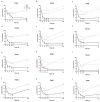Murepavadin Enhances the Killing Efficacy of Ciprofloxacin against Pseudomonas aeruginosa by Inhibiting Drug Efflux
- PMID: 39334985
- PMCID: PMC11429200
- DOI: 10.3390/antibiotics13090810
Murepavadin Enhances the Killing Efficacy of Ciprofloxacin against Pseudomonas aeruginosa by Inhibiting Drug Efflux
Abstract
Pseudomonas aeruginosa is a multidrug-resistant Gram-negative pathogen and one of the leading causes of ventilator-associated pneumonia and infections in patients with chronic obstructive pulmonary disease and cystic fibrosis. Murepavadin is a peptidomimetic that specifically targets outer-membrane lipopolysaccharide transport protein LptD of P. aeruginosa. In this study, we find that murepavadin enhances the bactericidal efficacy of ciprofloxacin. We further demonstrate that murepavadin increases intracellular accumulation of ciprofloxacin by suppressing drug efflux. In addition, the murepavadin-ciprofloxacin combination exhibits a synergistic bactericidal effect in an acute murine pneumonia model. In conclusion, our results identify an effective drug combination for the treatment of P. aeruginosa infections.
Keywords: Pseudomonas aeruginosa; ciprofloxacin; murepavadin.
Conflict of interest statement
The authors declare no conflicts of interest. The funders had no role in the design of the study; in the collection, analyses, or interpretation of data; in the writing of the manuscript; or in the decision to publish the results.
Figures





Similar articles
-
Murepavadin induces envelope stress response and enhances the killing efficacies of β-lactam antibiotics by impairing the outer membrane integrity of Pseudomonas aeruginosa.Microbiol Spectr. 2023 Sep 5;11(5):e0125723. doi: 10.1128/spectrum.01257-23. Online ahead of print. Microbiol Spectr. 2023. PMID: 37668398 Free PMC article.
-
Murepavadin promotes the killing efficacies of aminoglycoside antibiotics against Pseudomonas aeruginosa by enhancing membrane potential.Antimicrob Agents Chemother. 2024 Apr 3;68(4):e0153923. doi: 10.1128/aac.01539-23. Epub 2024 Mar 12. Antimicrob Agents Chemother. 2024. PMID: 38470195 Free PMC article.
-
Murepavadin antimicrobial activity against and resistance development in cystic fibrosis Pseudomonas aeruginosa isolates.J Antimicrob Chemother. 2021 Mar 12;76(4):984-992. doi: 10.1093/jac/dkaa529. J Antimicrob Chemother. 2021. PMID: 33367642
-
Sulopenem: An Intravenous and Oral Penem for the Treatment of Urinary Tract Infections Due to Multidrug-Resistant Bacteria.Drugs. 2022 Apr;82(5):533-557. doi: 10.1007/s40265-022-01688-1. Epub 2022 Mar 16. Drugs. 2022. PMID: 35294769 Review.
-
Combination antimicrobial susceptibility testing for acute exacerbations in chronic infection of Pseudomonas aeruginosa in cystic fibrosis.Cochrane Database Syst Rev. 2020 May 15;5(5):CD006961. doi: 10.1002/14651858.CD006961.pub5. Cochrane Database Syst Rev. 2020. PMID: 32412092 Free PMC article.
References
Grants and funding
LinkOut - more resources
Full Text Sources

